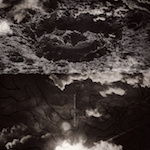|
2/21/15: The ecstasy of agony Back in the late 80s, the relatively cohesive metal scene splintered. Hair metal, of course, was already a different species. But bands as disparate as Metallica, Iron Maiden and Slayer shared many fans. Maiden was the final holdover from the "New Wave of British Heavy Metal" that inspired Metallica, and Slayer was one of the first popular (in a mainstream sense) thrash bands.
Enter the punks. Earache Records opened for business with the British release of the Accused's The Return of Martha Splatterhead in 1987. This was quickly followed by Napalm Death's Scum -- and the floodgates opened. I was curating the loud music show at my college radio station at the time, and I chose "loud music" as a description of what I played for a reason. No one could come up with anything else that explained a show that included Queensryche, Anthrax, Maiden, Metallica, Mercyful Fate (well, King Diamond by then), Fear, Flipper and all the other disparate stuff I played. The ferment increased. And Justice for All gave a blueprint for how to incorporate technology into loud music, and then Godflesh came along and blew that out of the water. Pantera's Cowboys from Hell was the first successful post-Justice American industrial metal album (though the band swerved back into more traditional metal sounds after that breathtaking debut). Bands like Tiamat started out as death metal and ended up somewhere in Pink Floydian territory. Dan Swano foisted a host of almost indefinable (but generally awesome) Swedish bands upon us. The early 90s were a heady time. And then it was all over. "Grunge" became the loud sound of the moment, and bands like Alice in Chains appropriated the "metal" moniker. Within a couple of years, anything out of the mainstream became known as "extreme." This applied to hardcore bands like Earth Crisis, metal bands like Fear Factory as well as anything else that wasn't Cannibal Corpse-style death metal (which was, of course, still death metal). Grunge faded, and "metal" defined stuff like System of a Down and the Mars Volta. The screamy stuff remained "extreme." I like "extreme." I like the fact that it is completely undescriptive, and it does have more cachet than my term, "loud music." Okay, then. Extreme (not the band) it is. But nobody really plays the proto-metallic screamy hardcore anymore. At least, I don't hear it. I've heard plenty of black metal (which has been around at least since MF, of course) and the odd attempts at modern death metal. But walls of sculpted sound hammered into sheets of throbbing pain, punctuated by shouts and screams? It's been a while. So when "The Window," the nearly 11-minute opening track from As We Draw's second album, Mirages brutalized my ears, I just knew. Holy shit. This is what I've been waiting for. Utilizing song structures that recall Streetcleaner's sledgehammer marches and adding curtains of guitar noise, As We Draw simply does not let up. This is pain of the highest order, dissonance wielded for maximum effect. Early Fudge Tunnel and Earth Crisis come to mind, though the production values here are much higher. Any distortion and muffling is intentional, not a by-product of engineering incompetence. Imagine the technical wizardry of TMV cycled through an "extreme" performance. That's really what As We Draw does. The playing is immaculate, and the production leaves no ear hair unsinged. This is an immersive experience, one that is best appreciated with the needles pinned. Just when I thought I was slowing down, As We Draw reminds me why I'm alive. The relentless energy of this album is addictive. There are few new ideas in music, but there are always new ways of interpreting old ideas. As We Draw uses all the modern conveniences to create its hurricane of pain. Agony rarely felt so good.
|
|
return to A&A home page
